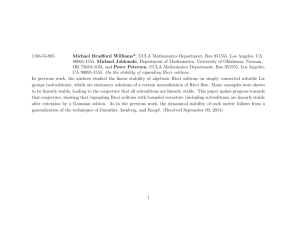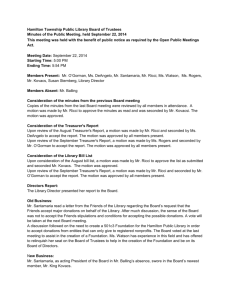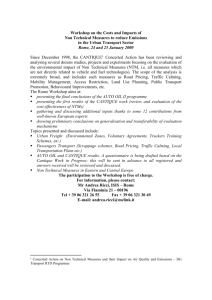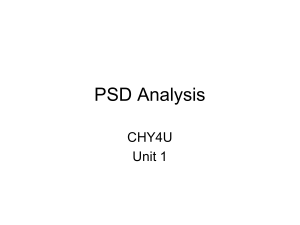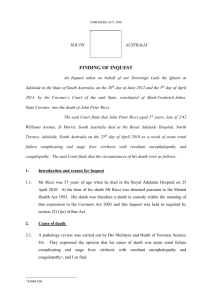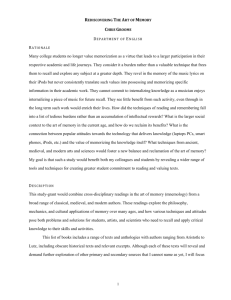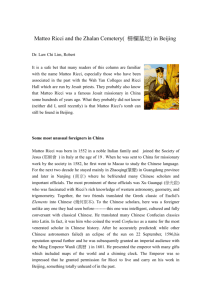L -preserving Schrodinger heat flow under the Ricci flow 2
advertisement
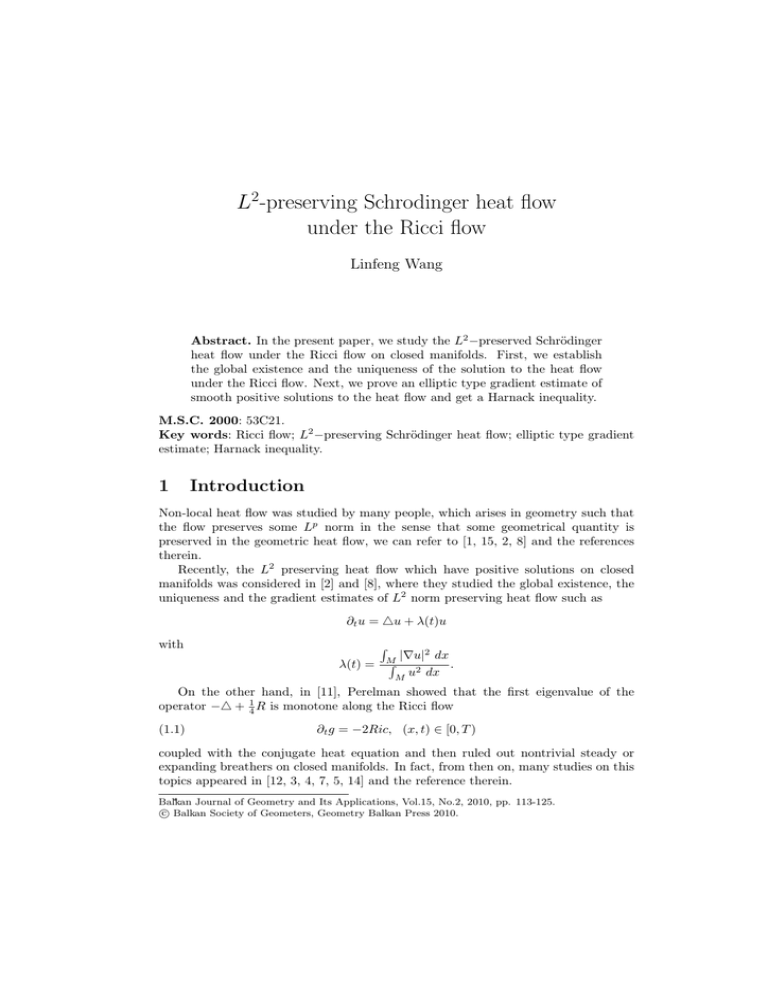
L2-preserving Schrodinger heat flow
under the Ricci flow
Linfeng Wang
Abstract. In the present paper, we study the L2 −preserved Schrödinger
heat flow under the Ricci flow on closed manifolds. First, we establish
the global existence and the uniqueness of the solution to the heat flow
under the Ricci flow. Next, we prove an elliptic type gradient estimate of
smooth positive solutions to the heat flow and get a Harnack inequality.
M.S.C. 2000: 53C21.
Key words: Ricci flow; L2 −preserving Schrödinger heat flow; elliptic type gradient
estimate; Harnack inequality.
1
Introduction
Non-local heat flow was studied by many people, which arises in geometry such that
the flow preserves some Lp norm in the sense that some geometrical quantity is
preserved in the geometric heat flow, we can refer to [1, 15, 2, 8] and the references
therein.
Recently, the L2 preserving heat flow which have positive solutions on closed
manifolds was considered in [2] and [8], where they studied the global existence, the
uniqueness and the gradient estimates of L2 norm preserving heat flow such as
∂t u = 4u + λ(t)u
with
R
λ(t) =
|∇u|2 dx
.
u2 dx
M
M
R
On the other hand, in [11], Perelman showed that the first eigenvalue of the
operator −4 + 14 R is monotone along the Ricci flow
(1.1)
∂t g = −2Ric, (x, t) ∈ [0, T )
coupled with the conjugate heat equation and then ruled out nontrivial steady or
expanding breathers on closed manifolds. In fact, from then on, many studies on this
topics appeared in [12, 3, 4, 7, 5, 14] and the reference therein.
∗
Balkan
Journal of Geometry and Its Applications, Vol.15, No.2, 2010, pp. 113-125.
c Balkan Society of Geometers, Geometry Balkan Press 2010.
°
114
Linfeng Wang
In this paper, we shall consider the following L2 −preserving Schrödinger heat flow
which have positive solutions on closed manifolds with the metric evolving under Ricci
flow (1.1):
∂t u = 4u + λ(t)u + cRu, in M × [0, T ),
u(x, 0) = h(x), in M,
where c ≥ 0 is a constant, h ∈ C 1 (M ), and λ(t) is chosen such that the flow preserves
the L2 −norm of the solution. By the fact that ∂t dx = −Rdx [6], a direct computation
shows
Z
Z
Z
Z
1 d
1
u2 dx = −
|∇u|2 dx + λ
u2 dx − ( − c)
u2 R dx,
2 dt M
2
M
M
M
hence
R
M
λ(t) =
|∇u|2 dx + ( 12 − c)
R
h2 dx
M
R
M
u2 R dx
R
can preserve the L2 −norm. Without loss of generality, we may assume that M |h|2 dx =
1 and h(x) ≥ 0. Thus we will consider the following L2 −preserving Schrödinger heat
flow on a closed manifold M with the metric evolving under Ricci flow (1.1):
(1.2)
(1.3)
∂t u = 4u + λ(t)u + cRu, in M × [0, T ),
u(x, 0) = h(x), in M,
where
(1.4)
Z
λ(t) =
1
|∇u|2 dx + ( − c)
2
M
Z
u2 R dx,
M
R
h(x) ≥ 0, M h2 dx = 1, h ∈ C 1 (M ) and T may be +∞. We establish a global
existence result about L2 −preserving Schrödinger heat flow.
Theorem 1.1. We assume that the Ricci flow (1.1) has a smooth solution on [0, T )(T
may be +∞) and the scalar curvature
of g(0) is nonnegative. Then the equation (1.2)
R
with initial value h(x) ≥ 0, M h2 (x) dx = 1 and h ∈ C 1 (M ) has a global solution
u ∈ L∞ ([0, T ), Ht1 (M )) ∩ L2loc ([0, T ), Ht2 (M )),
where Ht1 (M ), Ht2 (M ) denote H 1 (M ), H 2 (M ) about the metric g(t) respectively.
Theorem 1.2. We assume that the Ricci flow (1.1) has a smooth solution on [0, T )(T
may be +∞) and the scalar curvature of Rg(0) is nonnegative. Then the solution to
equation (1.2) with initial value h(x) ≥ 0, M h2 (x) dx = 1 and h ∈ C 1 (M ) is unique.
The Schrödinger heat equation
ut = 4u + qu
was discussed in [12], in this paper, by some parabolic type gradient estimates, the
authors got Harnack inequalities as the following type:
(1.5)
u(x1 , t1 ) ≤ u(x2 , t2 )(
αr2 (x1 , x2 ) nαK(t2 − t1 )
t2 nα
) 2 exp {
+ √
},
t1
4(t2 − t1 )
2(α − 1)
L2 -preserving Schrodinger heat flow under the Ricci flow
115
where α > 1 is a given constant, r(x1 , x2 ) is the geodesic distance between x1 , x2 and
0 < t1 < t2 < +∞.
The parabolic type gradient estimate for the positive solutions to the non-local
heat flow (1.2) when c = 0 was studied in [8], the Harnack inequality has the same type
as (1.5). But we can only compare the solutions at different times from the Harnack
inequalities with the type similar to (1.5). In order to overcome this blemish, we can
consider the elliptic type gradient estimate, the Harnack inequality deduced from this
estimate can be used to compare the solutions at the same time. Hamilton firstly
got this gradient estimate on a closed manifold in [9]; then in [13], this elliptic type
gradient estimate was proved on a complete noncompact Riemannian manifold, the
Harnack inequality with the following type was deduced by using this estimate:
u(x1 , t) ≤ u(x2 , t)η(t,r(x1 ,x2 )) e1−η(t,r(x1 ,x2 )) ,
where η(t, r(x1 , x2 )) depends on t, r(x1 , x2 ).
In this paper, we also prove an elliptic type gradient estimate for solutions to
equation (1.2), as an application, we get a Harnack inequality.
Theorem 1.3. We assume that the Ricci flow (1.1) has a smooth solution on√[0, T0 ]
and the scalar curvature of g(0) is nonnegative, for a constant G > 0, |∇ R| ≤
G, t ∈ [0, T0 ], u(x, t) is a positive smooth solution to (1.2) with u(x, t) ≤ e−1 for all
(x, t) ∈ M × (0, T ). Then
r
√
∇u
1
(1.6)
|
|≤
+ 2λ(t) + 2cG(1 − log u).
u
t
Theorem 1.4. We assume that the Ricci flow (1.1) has a smooth solution on√[0, T0 ]
and the scalar curvature of g(0) is nonnegative, for a constant G > 0, |∇ R| ≤
G, t ∈ [0, T0 ], u(x, t) is a positive smooth solution to (1.2) with u(x, t) ≤ e−1 for all
(x, t) ∈ M × (0, T ). Then for x1 , x2 ∈ M, t ∈ (0, T ),
u(x2 , t) ≤ e1−η(t,r(x1 ,x2 )) u(x1 , t)η(t,r(x1 ,x2 ))
(1.7)
where
(1.8)
√1
√
η(t, r(x1 , x2 )) = e− t +2λ(t)+ 2cGr(x1 ,x2 )
and r(x1 , x2 ) denotes the geodesic distance between x1 , x2 .
Remark We always need some conditions about the Ricci curvature when we
consider the elliptic or parabolic type gradient estimate(see [8, 12, 9, 13]). But in
Theorem 1.3 and Theorem 1.4, we give the elliptic type gradient estimate and the
Harnack inequality without any assumption about the Ricci curvature.
2
Some estimates
We assume that the Ricci flow (1.1) has a smooth solution on [0, T ) with R(x, 0) ≥ 0.
In [10], Hamilton get the evolution of the scalar curvature
∂t R = 4R + 2|Ric|2 .
116
Linfeng Wang
By the maximum principle, we deduce that
R(x, t) ≥ 0, (x, t) ∈ M × [0, T ).
We define a series u(k) as
Z
(0)
u
= h, λ
(k)
(t) =
1
(|∇u(k) |2 + ( − c)(u(k) )2 R) dx,
2
M
∂t u(k+1) = 4u(k+1) + λ(k) (t)u(k+1) + cRu(k+1) ,
u(k+1) (x, 0) = h(x).
(2.1)
For k ≥ 0,
1 d
2 dt
(2.2)
Z
Z
|∇u(k+1) |2 dx
M
M
Z
Z
1
(k)
(k+1) 2
(u(k+1) )2 R dx.
λ (t)
(u
) dx + (c − )
2 M
M
=
(u(k+1) )2 dx +
By ∂t g ij = 2g ik g jl Rkl , for a smooth function f (x, t),
Z
Z
d
|∇f |2 dx =
(2∇f · ∇ft + 2Ric(∇f, ∇f ) − |∇f |2 R) dx,
dt M
M
so
Z
1
|∇u
| dx + ( − c)
|∇u(k+1) |2 R dx
2
M
M
Z
Z
= λ(k)
|∇u(k+1) |2 dx +
Ric(∇u(k+1) , ∇u(k+1) ) dx
M
Z M
Z
(k+1)
(k+1)
+c
u
∇R · ∇u
dx −
(4u(k+1) )2 dx.
1 d
2 dt
(2.3)
Z
(k+1) 2
M
M
From (2.1),
Z
(k+1) 2
(ut
)
M
(k)
=
(2.4)
1 d
dx +
2 dt
Z
|∇u(k+1) |2 dx
M
Z
Z
d
λ(k)
|u(k+1) |2 dx +
(u(k+1) )2 R dx
2 dt M
2 M
Z
Z
1
(k+1) 2
|∇u
| R dx +
Ric(∇u(k+1) , ∇u(k+1) ) dx
−
2 M
M
Z
Z
c d
+ [
R(u(k+1) )2 dx +
R2 (u(k+1) )2 dx]
2 dt M
M
Z
c
(k+1) 2
−
∂t R(u
) dx.
2 M
λ
By the Ricci identity
(2.5)
viij = viji − Rij vi ,
L2 -preserving Schrodinger heat flow under the Ricci flow
we have
Z
117
Z
(4f )2 dx
= −
M
fiij fj dx
ZM
= −
(viji vj − Rij vi vj ) dx
Z
Z M
2
dx +
Rij vi vj dx.
=
vij
(2.6)
M
Note that
M
Z
1
f ∇R · ∇f dx = −
2
M
Z
f 2 4R dx,
M
hence (2.3) becomes
Z
Z
Z
1 d
1
|∇u(k+1) |2 dx + ( − c)
|∇u(k+1) |2 R dx +
|∇2 u(k+1) |2 dx
2 dt M
2
M
M
Z
Z
c
(k)
(k+1) 2
(2.7) = λ
4R(u(k+1) )2 dx,
|∇u
| dx −
2 M
M
which means that
Z
|∇u(k+1) |2 dx + c
4R(u(k+1) )2 dx
M
M
Z
Z
(k)
(k+1) 2
2λ
|∇u
| dx + 2c
|∇u(k+1) |2 R dx.
d
dt
(2.8)
≤
Z
M
M
(2.2) tells us that
Z
Z
Z
d
(2.9)
(u(k+1) )2 dx ≤ 2λ(k) (t)
(u(k+1) )2 dx + 2c
R(u(k+1) )2 dx.
dt M
M
M
By (2.6) and the fact that
|∇2 f |2 ≥
1
(4f )2 ,
n
we get
Z
(2.10)
Z
M
M
By (2.4) and (2.10),
Z
(k+1) 2
(ut
M
(k)
≤
(2.11)
|∇2 f |2 dx.
Ric(∇f, ∇f ) dx ≤ (n − 1)
1 d
2 dt
Z
|∇u(k+1) |2 dx
M
Z
(u(k+1) )2 R dx + (n − 1)
|∇2 u(k+1) |2 dx
2 M
M
Z
Z
c d
(k+1) 2
2 (k+1) 2
+ [
R(u
) dx +
R (u
) dx]
2 dt M
M
Z
Z
λ(k) d
c
∂t R(u(k+1) )2 dx +
|u(k+1) |2 dx.
−
2 M
2 dt M
λ
Z
) dx +
118
Linfeng Wang
Lemma 2.1. We can choose a positive number δ < T2 , such that for some conT
Rstant C 2> 0 depending on M = max {R(x, t) + |4R(x, t)||(x, t) ∈ M × [0, 2 ]} and
|∇h| dx(g(0)),
M
Z
(2.12)
|u(k+1) |2 dx(t) ≤ C, t ∈ [0, δ],
M
Z
(2.13)
|∇u(k+1) |2 dx(t) ≤ C, t ∈ [0, δ],
Z
M
δ
Z
|∇2 u(k+1) |2 dx dt ≤ C, t ∈ [0, δ],
(2.14)
Z
0
δ
Z
M
(k+1) 2
(2.15)
0
M
(ut
) dx(t) dt ≤ C, t ∈ [0, δ].
Proof. We firstly show that (2.14) and (2.15) can be deduced by (2.12) and (2.13).
Integrate (2.7) with t on [0, δ],
Z δZ
2
|∇2 u(k+1) |2 dx dt
0
Z
M
Z
2
≤
|∇h| dx(0) + 2
M
(2.16)
Z
δ
λ
(k)
Z
|∇u(k+1) |2 dx(t) dt
(t)
0
M
Z
δ
(k+1) 2
+cM
(u
0
Z
δ
Z
|∇u(k+1) |2 dx(t) dt.
) dx dt + 2cM
M
0
M
Note the evolution of R, integrate (2.11) with t on [0, δ],
Z δZ
(k+1) 2
2
(ut
) dx(t) dt
0
Z
M
≤
δ
|∇h| dx(0) +
M
Z
+M
Z
δ
λ
Z
(2.17)
Z
2
0
(k)
(t)
λ
0
(u
(k)
d
(t)
dt
Z
|u(k+1) |2 dx(t) dt
M
Z
Z
|∇2 u(k+1) |2 dx(t) dt
) dx(t) dt + (n − 1)
M
0
Z
δ
R(x, δ)(u(k+1) )2 dx(δ) + cM (M + 1)
+c
δ
(k+1) 2
M
0
Z
M
(u(k+1) )2 dx dt.
M
By (2.12) and (2.13), after a suitable adjustment of C, we know
(2.18)
λ(k) (t) ≤ C, t ∈ [0, δ].
By (2.12), (2.13), (2.16), (2.17) and (2.18), after a suitable adjustment of C, we get
(2.14) and (2.15).
Now we prove (2.12) and (2.13) by induction, we assume that for suitable δ > 0
and C picked later, (2.12) and (2.13) are right for k. Integrate (2.9) with t, we get
Z
Z
Z t
(k+1) 2
2
|u
| dx ≤
|h| dx(0) exp (
(2λ(k) (t) + 2cM ) dt)
M
M
0
Z
(2.19)
≤
|h|2 dx(0)e(2C+CM +2cM )t , t ∈ [0, δ].
M
L2 -preserving Schrodinger heat flow under the Ricci flow
119
By (2.8) and (2.19), for t ∈ [0, δ],
Z
d
|∇u(k+1) |2 dx
dt M
Z
Z
2
(2C+CM +2cM )t
≤ M
|h| dx(0)e
+ (2C + CM + 2cM )
M
or
d
[
dt
|∇u(k+1) |2 dx,
M
Z
Z
|∇u(k+1) |2 dxe−(2C+CM +2cM )t − M
M
|h|2 dx(0)t] ≤ 0,
M
which means that for t ∈ [0, δ],
Z
Z
(k+1) 2
|∇u
(2.20)
| dx ≤
(h2 + M δ|∇h|2 ) dx(0)e(2C+CM +2cM )δ .
M
M
We choose δ > 0 small so that for suitable constant C > 0,
Z
(h2 + M δ|∇h|2 ) dx(0)e(2C+CM +2cM )δ ≤ C.
M
By (2.19) and (2.20), we can see (2.12) and (2.13) are right for k + 1.
3
¤
Global existence
Let Γ be the maximal subset of [0, T ) such that (1.2) has a global solution
u ∈ L∞ (Γ, Ht1 (M )) ∩ L2loc (Γ, Ht2 (M )).
In this section, we shall prove that Γ = [0, T ). The proof consists of three steps,
the main idea comes from [2, 8].
R
Step1 We will show that there exists a positive number δ depending on M |∇h|2 dx(0)
and M , such that [0, δ] ⊂ Γ.
We use Ht1 (M ), Ht2 (M ), L2t (M ) to denote H 1 (M ), H 2 (M ), L2 (M ) of g(t). By
Lemma 2.1, there is a subsequence of {u(k) } (still denoted by {u(k) }) and a function
u(x, t) ∈ L∞ ([0, δ], Ht1 (M )) ∩ L2 ([0, δ], Ht2 (M ))
with ∂t u(x, t) ∈ L2 ([0, δ], L2t (M )), such that u(k) * u weak* in L∞ ([0, δ], Ht1 (M )) and
weakly in L2 ([0, δ], Ht2 (M )). Then we have u(k) → u strongly in L2 ([0, δ], Ht1 (M ))
and u(x, t) ∈ C([0, δ], L2t (M )). Hence λ(k) (t) → λ(t) strongly in L2 ([0, δ]). Thus, we
get a local strong solution to equation (1.2) under the Ricci flow (1.1). So Γ is not
empty.
Step2 Let u(x, t) be a solution to (1.2) on [0, t0 ), where t0 ∈ (0, T ), we assume
that
Ric(x, t) ≤ N (t0 )g(x, t), (x, t) ∈ M × [0, t0 ],
and
R(x, t) ≤ M (t0 ), (x, t) ∈ M × [0, t0 ],
120
Linfeng Wang
for some constants N (t0 ), M (t0 ) depending on t0 .
We can compute as
(3.1)
d
dt
Z
2
=
Z
Z
Z
2
2
(4u) dx − 2λ(t)
|∇u|2 dx
M
Z
Z
Ric(∇u, ∇u) dx + (2c − 1)
R|∇u|2 dx − c
4Ru2 dx.
|∇u| dx + 2
M
M
M
M
M
Note that
Z
(
(3.2)
Z
2
Z
2
2
|∇u| dx) = (−
M
(4u)2 dx.
u4u dx) ≤
M
M
For t ∈ [0, t0 ),
d
dt
Z
Z
2
|∇u|2 dx + cM (t0 ),
|∇u| dx ≤ D
M
M
where
D = (1 + 2c)M (t0 ) + 2N (t0 ),
or
Z
d
cM (t0 ) −Dt
[(
|∇u|2 dx +
)e
] ≤ 0.
dt M
D
So for t ∈ [0, t0 ),
Z
Z
2
(3.3)
|∇h|2 dx(g(0)) +
|∇u| dx ≤ [
M
M
cM (t0 ) Dt cM (t0 )
]e −
.
D
D
Similar to (2.7) and (2.11), we have
Z
Z
2
|∇u| dx + 2
|∇2 u|2 dx
M
Z
Z
Z
2λ(t)
|∇u|2 dx + 2c
R|∇u|2 dx − c
∂t
M
(3.4)
≤
M
M
4Ru2 dx,
M
and
Z
Z
c
1
|∇u|2 dx +
∂t Ru2 dx
(ut )2 dx + ∂t
2
2
M
M
M
Z
Z
λ(t)
2
2 2
≤
Ru dx + (n − 1)
|∇ u| dx
2 M
M
Z
Z
c d
+ [
Ru2 dx +
R2 u2 dx].
2 dt M
M
Z
(3.5)
By (3.3), (3.4) and (3.5), we conclude that there exists a constant C depending on
L2 -preserving Schrodinger heat flow under the Ricci flow
121
R
|∇h|2 dx(g(0)) and t0 , such that for t ∈ [0, t0 ),
Z
(3.6)
|∇u|2 dx ≤ C,
M
Z
∂t
(3.7)
|∇u|2 dx ≤ C,
Z M
(3.8)
|∇2 u|2 dx ≤ C,
M
Z
(3.9)
(ut )2 dx ≤ C.
M
M
So for t0 ∈ (0, T ), if [0, t0 ) ⊂ Γ, then [0, t0 ] ⊂ Γ.
R
Step3 Assume that [0, t0 ] ⊂ Γ, from Step 2, we know that M |∇u|2 dx(g(t0 ))
is bounded. Now follow the procedure in Step 1, we will get a local strong solution
to (1.2)
under the Ricci flow (1.1) on [t0 , t0 + δ) for δ > 0 small enough depending
R
on M |∇u|2 dx(g(t0 )) and max {R(x, t)|(x, t) ∈ M × [t0 , t0 +T
2 ]}. Which means that
[t0 , t0 + δ) ⊂ Γ.
As a subset of [0, T ), Γ is not empty, moreover, it is both open and closed, so we
conclude that Γ = [0, T ) and Theorem 1.1 follows.
4
Uniqueness
We assume that u, v are two solutions to (1.2) with initial value hu , hv under the Ricci
flow (1.1). Then,
Z
Z
1 d
1
(u − v)2 dx =
[(u − v)(ut − vt ) − (u − v)2 R] dx
2 dt M
2
Z
ZM
≤ −
|∇(u − v)|2 dx +
(u − v)(λu (t)u − λv (t)v) dx
M
M
Z
(4.1)
+c
R(u − v)2 dx,
M
where
Z
λu (t) =
and
Z
λv (t) =
Note that
1
|∇u|2 dx + ( − c)
2
M
1
|∇v|2 dx + ( − c)
2
M
Z
u2 R dx,
M
Z
v 2 R dx.
M
Z
(u − v)(λu (t)u − λv (t)v) dx
Z
Z
= (λu (t) − λv (t))
(u − v)u dx + λv (t)
(u − v)2 dx
M
M
Z
Z
≤ |λu (t) − λv (t)|(
(u − v)2 dx)1/2 + |λv (t)|
(u − v)2 dx,
M
(4.2)
M
M
122
Linfeng Wang
and
|λu (t) − λv (t)|
(4.3)
Z
Z
1
= |
(|∇u|2 − |∇v|2 ) dx + ( − c)
(u2 − v 2 )R dx|
2
M
M
Z
Z
1
≤
|∇(u − v)|(|∇u| + |∇v|) dx + | − c|
(u2 − v 2 )R dx
2
M
M
Z
Z
≤ (
|∇(u − v)|2 dx)1/2 (
(|∇u| + |∇v|)2 dx)1/2
M
M
Z
Z
1
2
(u − v) dx)1/2 (
((u + v)R)2 dx)1/2 .
+| − c|(
2
M
M
From Section
2, we know that
R
R for every t0 ∈ (0, T ), there exists a constant C depending on M |∇hu |2 dx(g(0)), M |∇hv |2 dx(g(0)) and t0 such that
|R(x, t)| + |4R(x, t)| ≤ C, (x, t) ∈ M × [0, t0 ],
Z
Z
2
|∇u| dx ≤ C,
|∇v|2 dx ≤ C, t ∈ [0, t0 ],
M
M
and
|λu (t)| ≤ C, |λv (t)| ≤ C, t ∈ [0, t0 ].
Together with (4.1), (4.2) and (4.3), we get that on [0, t0 ],
Z
Z
1 d
(u − v)2 dx ≤ (3c + 3)C
(u − v)2 dx,
2 dt M
M
and we conclude that
Z
Z
2
(4.4)
(u − v) dx ≤
M
(hu − hv )2 dx(g(0))e(6c+6)Ct , t ∈ [0, t0 ].
M
Further more,
≤
(4.5)
and
Z
1 d
|∇(u − v)|2 dx
2 dt M
Z
Z
−
|∇2 (u − v)|2 dx +
∇(u − v) · ∇(λu (t)u − λv (t)v) dx
M
M
Z
Z
c
+c
R|∇(u − v)|2 dx −
4R(u − v)2 dx,
2 M
M
Z
∇(u − v) · ∇(λu (t)u − λv (t)v) dx
Z
Z
(λu (t) − λv (t))
∇(u − v) · ∇u dx + λv (t)
|∇(u − v)|2 dx
M
M
Z
Z
2
1/2
|λu (t) − λv (t)|(
|∇u| dx) (
∇(u − v) dx)1/2
M
M
Z
+|λv (t)|
|∇(u − v)|2 dx.
M
=
≤
(4.6)
M
L2 -preserving Schrodinger heat flow under the Ricci flow
123
By (4.3) and (4.4), we know that for t ∈ [0, t0 ],
√ Z
√
|λu (t) − λv (t)| ≤ 2 C(
|∇(u − v)|2 dx)1/2 + (1 + 2c)C De(3c+3)Ct ,
M
where
Z
(hu − hv )2 dx(g(0)).
D=
M
Hence we get the following differential inequality on [0, t0 ],
1 d
X(t)
2 dt
(4.7)
p
√
cCD (6c+6)Ct
≤ (3 + c)CX(t) + (1 + 2c)C CDe(3c+3)Ct X(t) +
e
2
1 + 2c
c
≤ (4 + c)CX(t) + [
C + ]CDe(6c+6)Ct ,
4
2
where
Z
|∇(u − v)|2 dx, t ∈ [0, t0 ].
X(t) =
M
Now we begin to prove Theorem 1.2.
Proof. when hu = hv , by (4.4),
Z
(u − v)2 dx = 0.
M
By (4.7),
X(t) ≤ X(0)e(8+2c)Ct = 0, t ∈ [0, δ].
So u = v, t ∈ [0, t0 ], Theorem 1.2 follows for the arbitrariness of t0 ∈ [0, T ).
5
¤
Elliptic type gradient estimate
Maximum principle is an important tool in geometric analysis, we can refer to [12,
13, 16] and the references therein. In this section, by using maximum principle, we
will prove elliptic type gradient estimate for positive solutions to (1.2).
Let u be a positive smooth solution to (1.2), f = log u, then f satisfies
(5.1)
ft = 4f + |∇f |2 + λ + cR.
Let
(5.2)
w = |∇f |2 (1 − f )−2 .
By the Ricci identity (2.5), we can compute as follows,
∂t w
(5.3)
(5.4)
= [2∇f · ∇4f + 2∇f · ∇|∇f |2 + 2c∇f · ∇R + 2Ric(∇f, ∇f )](1 − f )−2
+2|∇f |2 (4f + |∇f |2 + λ + cR)(1 − f )−3 ,
∇w = ∇|∇f |2 (1 − f )−2 + 2|∇f |2 (1 − f )−3 ∇f,
124
Linfeng Wang
and
4w
=
(5.5)
4∇f · ∇|∇f |2 (1 − f )−3 + 6|∇f |4 (1 − f )−4 + 24f |∇f |2 (1 − f )−3
+[2|∇2 f |2 + 2∇f · ∇4f + 2Ric(∇f, ∇f )](1 − f )−2 .
By (5.2), (5.3), (5.4) and (5.5),
(∂t − 4)w
=
2f w2 + (2 − 4(1 − f )−1 )∇f · ∇w + 2c∇f · ∇R(1 − f )−2
+2λ(1 − f )−1 w − 2|∇2 f |2 (1 − f )−2 + 2cRw(1 − f )−1 ,
or
(5.6)
(∂t − 4)(tw)
= 2tf w2 + (2 − 4(1 − f )−1 )t∇f · ∇w + 2ct∇f · ∇R(1 − f )−2
+2tλ(1 − f )−1 w − 2t|∇2 f |2 (1 − f )−2 + w + 2ctRw(1 − f )−1 .
For T0 , 0 < T0 < T , let (x0 , t0 ) be the maximal point of wt on M × [0, T0 ],
we assume the maximum value is positive and so t0 > 0, then at (x0 , t0 ), we have
(∂t − 4)(tw) ≥ 0, and ∇(tw) = 0. Since f ≤ −1, by (5.6), we get that at (x0 , t0 ),
≤
Note that
t(1 − f )w2 ≤ −2f tw2
w + 2λt(1 − f )−1 w + 2ct(1 − f )−2 ∇f · ∇R + 2ctRw(1 − f )−1 .
√
(1 − f )−2 ∇f · ∇R + (1 − f )−1 wR ≤ (1 − f )−1 |∇ R|2 ,
so at (x0 , t0 ),
(tw)2 ≤ (1 + 2λT0 )tw + 2cGT02 ,
in particular, for all x ∈ M ,
T0 w(x, T0 ) ≤ t0 w(x0 , t0 ) ≤ 1 + 2λT0 +
√
2cGT0 ,
so
(5.7)
w(x, T0 ) ≤
√
1
+ 2λ + 2cG.
T0
For the reason that T0 ∈ (0, T ) is arbitrary, we get (1.6).
In order to show the Harnack inequality, let’s consider the minimal geodesic γ(s) :
[0, 1] → M , so that γ(0) = x2 , γ(1) = x1 , by using (1.6), we have
Z 1
Z 1
1 − f (x1 , t)
d ln (1 − f (γ(s), t))
−γ 0 · ∇f
ln
=
ds =
ds
1 − f (x2 , t)
ds
0
0 1 − f (γ(s), t)
r
Z 1
√
1
|∇u|
0
ds ≤ r(x1 , x2 )
+ 2λ + 2cG.
≤
|γ |
u(1 − ln u)
t
0
This inequality means (1.7) is right.
Acknowledgement. The present work was supported by the Doctoral Foundation of Nantong University (08B04), by NSF of Jiangsu Educational Ministry
(08KJD110015) and by NSF of China (10871070, 10971066).
L2 -preserving Schrodinger heat flow under the Ricci flow
125
References
[1] T. Aubin, Some nonlinear problems in Riemannian geometry, Springer Monogr.
Math., Springer-Verlag 1998.
[2] C. Caffarelli, F. Lin, Nonlocal heat flows preserving the L2 energy, Discrete and
Continuous Dynamical Systems 23 (2009), 49-64.
[3] Q.H. Cai, P.B. Zhao, On stability of Ricci flows based on bounded curvatures,
Balkan J. Geom. Appl. 15, 2 (2010), 34-46.
[4] X.D. Cao, Eigenvalues of (−4 + R2 ) on Manifolds with nonnegative curvature
operator, Mathematische Annalen 337, 2 (2007), 435-441.
[5] S.Ch. Chang, P. Lu, Evoluation of Yamabe constants under Ricci flow, Ann.
Glob. Anal. Geom. 31 (2007), 147-153.
[6] B. Chow, D. Knopf, The Ricci Flow: An Introduction, Mathematical Surveys
and Monographs, Amer. Math. Soc. 2004.
[7] J.F. Li, Eigenvalues and energy functionals with monotonicity formulae under
Ricci flow, Mathematische Annalen 338, 24 (2007), 927-946.
[8] L. Ma, L. Cheng, Non-Local heat flows and gradient estimates on closed manifolds, Journal of Evolution Equation 9, 4 (2009), 787-807.
[9] R. Hamilton, A matrix Harnack estimate for the heat equation, Comm. Anual.
Geom. 1 (1993), 113-126.
[10] R. Hamilton, Three-manifolds with positive Ricci curvature, J. Differential Geom.
17, 2 (1982), 255-306.
[11] G. Perelman, The entropy formula for the Ricci flow and its geometric applications, arxiv: Math. DG/0211159, 2002.
[12] L. Peter, S.T. Yau, On the parabolic kernel of the Schrödinger operator, Acta.
Math. 156, 3-4 (1986), 153-201.
[13] P. Souplet, Q.S. Zhang, Sharp gradient estimate and Yau’s Liouville theorem for
the heat equation on noncompact manifolds, Bull London Math. Soc. 38 (2006),
1045-1053.
[14] N. Sesum, G. Tian, Bounding scalar curvature and diameter along the Kähler
Ricci flow (after Perelman) and some applications, Journal of the Institute of
Mathematics of Jussieu, 7 (2008), 575-587.
[15] M. Struwe, Variational Methods, 3-nd edition, Springer, 2000.
[16] C. Udrişte, Nonholonomic approach of multitime maximum principle, Balkan J.
Geom. Appl. 14, 2 (2009), 101-116.
Author’s address:
Linfeng Wang
School of Science, Nantong University,
Nantong, 226007, Jiangsu, P.R. China.
E-mail: wlf711178@126.com, wlf711178@ntu.edu.cn
